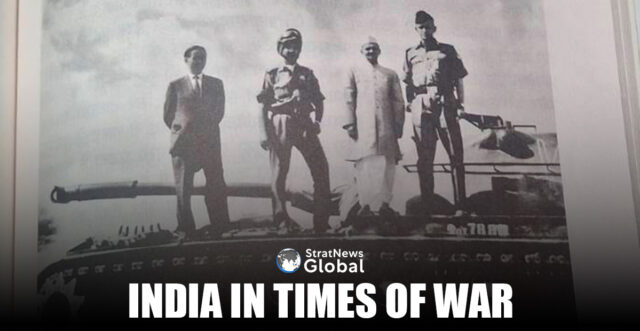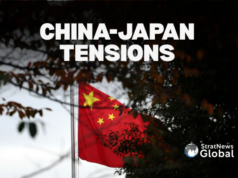Exactly six decades ago, an aggressive and reckless Pakistan—like it is now—thought India could be brought to its knees and Kashmir can be wrested away from India. But like in present times, political parties put aside their differences, citizens stepped up and contributed to the war effort in a big way. As the nation prepares to get ready for any wider war in coming weeks and a nationwide mock drill gets underway on Wednesday, here’s a look back at what happened in 1965 war. From a chapter in my book, 1965: Turning the tide. How India won the war
———————————
1965 War: The Civilian Effort
The 22-day war, mainly confined to the North, would not have ended in India’s favour if the civilian population—truck drivers, labourers, ordinary shopkeepers, housewives, farmers and Punjab government employees had not contributed their might. The citizens of Amritsar city deserve a special mention. The city bore the brunt of Pakistani air raids and suffered a heavy blow to its infrastructure and economy in the daily air raids attempted by the Pakistani Air Force. Across Punjab and Jammu, civilians rose to the occasion.
DR Mankekar records: “Party and communal barriers dissolved in the heat of war and leaders and common people plunged into voluntary civil defence work. Cheering crowds saw marching troops off to the front, garlanded them and their ranks and vehicles, applied kum-kum to their foreheads…”
Pakistan radio tried to woo the Sikhs, who were then agitating for a separate state but to no avail. Farmers cut their crops prematurely to catch hiding Pakistanis in the fields; housewives and young girls joined community effort to make thousands of chappatis; hundreds of packets containing chappatis, parched gram and gur were made and flung into passing Army vehicles. The ‘food packets’ came in handy to the troops hastily rushed into the battle. As Gen Harbakhsh notes: “Much of the gallantry and self-sacrifice of the Indian jawan was due to their confidence that the whole country was behind him…the enthusiasm of the civilian population of the area and the emotional backing which they gave to the advancing troops was to be seen to be believed. Food, milk, tea and cold drinks were served free to troops round the clock at numerous stalls set up behind the front lines. The courage and self-confidence shown by the peasant population in the forward areas also inspired the troops.”
In the early days of fighting, when the Army was moving constantly, this help was a great morale booster.
Civilian truck drivers—nearly 1500 of them—gallantly offered their services. Many of them faced bombing, a few got killed but most stuck to their task sometimes driving their heavy trucks through the dark because of the blanket blackout imposed on the entire state. An entire armoured division was assembled in the forward area in less than 24 hours thanks to about 150 brave truck drivers summoned for the job at 24 hours notice! The trucks often transported troops to the farthest point possible in absence of adequate military transport. On their return journey, many of them started bringing back Pakistani prisoners of war. Mankekar writes: “Atma Ram of Amritsar was one of the truck drivers who carried suppliers to the forward dumps and on the return journey brought the wounded and Pakistani PoWs. One night his convoy was bringing the POWs back, Pakistani bombers chased the convoy along the route and tried to bomb them. The convoy came to a halt and the Indian jawans jumped out to take up positions while Atma Ram and his comrades guarded the trucks containing POWs lest they escape in the darkness.”
There is another instance of heroism by civilian truck owner and driver narrated by Mankekar. “Truck owner Bhagwan Das and his driver Khairati Lal belonged to a convoy detailed in the Fazilka sector. They were in the thick of a fluid battle which swung back and forth. For seven consecutive days and nights they were on the move, pursued by Pak bombers like vultures. Their orders were: ‘save the ammunition.’ They carried out the order, come what may; they drove, day and night, without rest or sleep, speeding, halting, speeding again, and when thirsty, drinking water from their truck radiators.”
Even a notorious smuggler, Sajjan Singh from Dall, a village bang on the border too joined in the war effort! He apparently told the police who caught him trying to smuggle opium—in the middle of the war—“Sir I have hitherto braved death for my belly; now I want to brave death for my country.” Indeed, he became an invaluable asset, bringing in intelligence in the Lahore sector.
Sarpanches—heads of villages of border settlements—stayed back with their families to help the Army with logistics and intelligence.
The boys and girl cadets of the National Cadet Corps (NCC) also a stellar role in defending vital installations, railway lines and helping in crucial tasks. According to the Extraordinary Gazette of India Published on 9 Sep 1965 in exercise of the powers conferred by Section 10 of the National Cadet Corps Act, 1948 (31 of 1948), the Central Government prescribed the following duties to be performed by the National Cadet Corps Officers (Senior, Junior and Girls Division) and Cadets (including girls) of the Senior Division who were of the age of seventeen years and above, namely:-
- Passive Air Defence including rescue work, first aid, evacuation of casualties, fire-fighting and removal of debris.
- Manning of Civil Defence posts including civil defence patrols and look outs.
- Maintenance of essential services such as motor transport, pioneer and engineer services, water supply and power supply.
- Traffic control.
- Manning of static signal installations.
- Messenger service.
- Duties in hospital.
- Administration and running of camps in case of movement of civil population.
- Any other allied duties.
These duties were performed by the cadets with full zeal and enthusiasm. The cadets also helped in building bunds along the western borders. The cadets were guards at important installations like Akashwani, telephone exchanges and post offices.
The railways too played a big part in mobilizing the Army to the frontline. Railway employees braved bombings and chaotic situations to carry tanks, troops and ammunition to the farthest point possible. According to reports of the time, 20 railway employees died in the line of duty during the war. In one instance, Chaman Lal , a fireman with the Northern Railway sacrificed his life in saving a train carrying diesel. He was sitting in a stationary locomotive at the Gurdaspur Railway station when a goods train carrying diesel was strafed by Pakistani planes. As one wagon caught fire, Chaman Lal rushed out of his engine and started delinking the wagon on fire from the rest of the train. He did save the train but succumbed to the burn injuries.
The villagers also played an extraordinary part in capturing Pakistani paratroopers who were dropped into Punjab in the middle of the war to destroy vital installations and cut off Indian supply lines. Well-trained paratroopers from the crack Special Service Group (SSG) were air-dropped around the airfields of Pathankot, Halwara and Adampur. Their mission was to destroy the aircraft, and vital installations at the airfields. In each case, villagers were first responders in spotting them, informing the police and Army authorities and even apprehending the. As Gen Harbakhsh gracefully notes: “In dealing with these paratroopers, the villagers took a major part in first informing of their presence and then chasing and surrounding them, with nothing more than ‘lathis’ until the ad hoc forces could arrive at the scene. In certain cases, the villagers overpowered armed paratroopers and handed them over to the military authorities. In all cases, the peasantry showed great patriotism, courage and determination.”
As the situation blew up into a full-fledged war, offers of help and support towards the war effort started flooding in from different parts of the country. SL Kirloskar, the chairman of FICCI (Federation of Indian Chamber of Commerce) appealed to every businessman in every city, town and village to do his duty by the motherland. He stressed the need for the wheels of production to be made faster to keep up with the war demands. In Shimla, the Federation of All India Jammu and Kashmir Labour volunteered to depute its entire membership of 5000 people for any defensive role that the country may find for them.
As all major cities prepared for blackouts and geared up the civil defence mechanisms, Delhi was divided into ten zones for civil defence. Delhi’s Municipal Press Karamchari Union, which was threatening to go on strike for redressing its grievances, shelved the idea and instead, all the members decided to contribute a day’s pay to the National Defence Fund.
The threat of enemy air raids on towns and cities loomed large. Several towns, including Ambala, bore the brunt of this, including damage to civilian areas and the military hospital. Blackouts at night were a routine precaution taken in all major cities, including Delhi and Mumbai. But the living weren’t the only ones who had to be thus inconvenienced. The civil defence measures included banning the burning of funeral pyres between 5 pm and 6 am to avoid presenting a target to enemy aircraft. The annual Ram Leela at Delhi, one of the highlights of the festive season every year, was also cancelled for similar reasons. The All India Boy Scouts Association came forward and offered their services in civil defence jobs, as did several other organisations, including the Gram Raksha Dal and former INA soldiers under the leadership of Mr Mohan Singh, an MP at that time and himself a former INA commander. JamAir, private airlines belonging to the Jam Sahib of Nawanagar offered their aircraft to ferry troops and essential war supplies.
Blood donation camps were held throughout the country, and people donated generously to the National Defence Fund, even going to the extent of offering their family ornaments to the cause of the nation. Young men, eager to fight the enemy thronged the recruitment offices across the country. Truck drivers from across the country offered their services, and were often used to ferry supplies and stores meant for the fighting troops right up to the border. They did so cheerfully and unmindful of the dangers they themselves faced.
Politicians from all political parties rallied around the government and Prime Minister Shastri, supporting his actions and decisions firmly. Every statement by the Prime Minister or the Defence Minister YB Chavan in the parliament giving out the progress of operations and exploits of the Indian soldiers met with cheers from members all around. Member after member spoke in the parliament, assuring the government their unequivocal support in the hour of national crisis.
Finally, some units of the Border Security Force (BSF), Punjab armed Police (PAP), the Rajasthan Armed Constabulary (RAC) and the Central Reserve Police Force (CRPF) made substantial contribution in the 1965 war. From Kargil to Kutch, they played supporting and many a times even an offensive role.
In sum, the nation as a whole rose to the occasion and secured a creditable win against all odds. This extraordinary turn around in the
country’s fortune after the despondency post-1962, came as major morale booster. Fifty years later, one can only salute all those who made the victory possible.
Nitin A. Gokhale is a media entrepreneur, one of South Asia's leading strategic affairs analyst and author of over a dozen books so far on military history, insurgencies and wars.
Starting his career in journalism in 1983, he has since led teams of journalists across media platforms.
A specialist in conflict coverage, Gokhale has covered the insurgencies in India’s North-East, the 1999 Kargil conflict and Sri Lanka’s Eelam War IV between 2006-2009.
Gokhale now travels across the globe to speak at seminars and conferences, and lecture at India’s premier defence colleges. He has founded three niche portals, Bharatshakti.in, stratnewsglobal.com and Interstellar.news.





